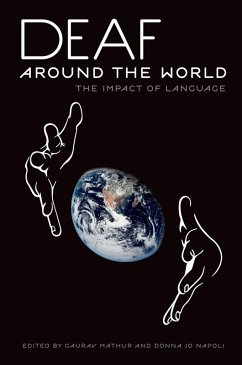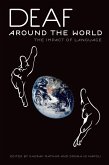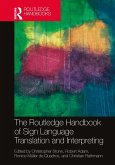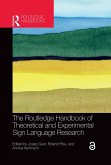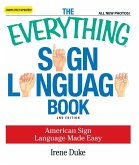Deaf around the World (eBook, ePUB)
The Impact of Language
Redaktion: Mathur, Gaurav; Napoli, Donna Jo
36,95 €
36,95 €
inkl. MwSt.
Sofort per Download lieferbar

18 °P sammeln
36,95 €
Als Download kaufen

36,95 €
inkl. MwSt.
Sofort per Download lieferbar

18 °P sammeln
Jetzt verschenken
Alle Infos zum eBook verschenken
36,95 €
inkl. MwSt.
Sofort per Download lieferbar
Alle Infos zum eBook verschenken

18 °P sammeln
Deaf around the World (eBook, ePUB)
The Impact of Language
Redaktion: Mathur, Gaurav; Napoli, Donna Jo
- Format: ePub
- Merkliste
- Auf die Merkliste
- Bewerten Bewerten
- Teilen
- Produkt teilen
- Produkterinnerung
- Produkterinnerung

Bitte loggen Sie sich zunächst in Ihr Kundenkonto ein oder registrieren Sie sich bei
bücher.de, um das eBook-Abo tolino select nutzen zu können.
Hier können Sie sich einloggen
Hier können Sie sich einloggen
Sie sind bereits eingeloggt. Klicken Sie auf 2. tolino select Abo, um fortzufahren.

Bitte loggen Sie sich zunächst in Ihr Kundenkonto ein oder registrieren Sie sich bei bücher.de, um das eBook-Abo tolino select nutzen zu können.
The articles in Deaf around the World offer an introduction to deaf studies and the study of signed languages.
- Geräte: eReader
- mit Kopierschutz
- eBook Hilfe
- Größe: 11.56MB
Andere Kunden interessierten sich auch für
![Deaf around the World (eBook, PDF) Deaf around the World (eBook, PDF)]() Deaf around the World (eBook, PDF)46,95 €
Deaf around the World (eBook, PDF)46,95 €![The Routledge Handbook of Sign Language Translation and Interpreting (eBook, ePUB) The Routledge Handbook of Sign Language Translation and Interpreting (eBook, ePUB)]() The Routledge Handbook of Sign Language Translation and Interpreting (eBook, ePUB)45,95 €
The Routledge Handbook of Sign Language Translation and Interpreting (eBook, ePUB)45,95 €![The Routledge Handbook of Theoretical and Experimental Sign Language Research (eBook, ePUB) The Routledge Handbook of Theoretical and Experimental Sign Language Research (eBook, ePUB)]() The Routledge Handbook of Theoretical and Experimental Sign Language Research (eBook, ePUB)48,95 €
The Routledge Handbook of Theoretical and Experimental Sign Language Research (eBook, ePUB)48,95 €![The Shetland Dialect (eBook, ePUB) The Shetland Dialect (eBook, ePUB)]() Peter SundkvistThe Shetland Dialect (eBook, ePUB)44,95 €
Peter SundkvistThe Shetland Dialect (eBook, ePUB)44,95 €![Languages (eBook, ePUB) Languages (eBook, ePUB)]() Stephen AndersonLanguages (eBook, ePUB)4,99 €
Stephen AndersonLanguages (eBook, ePUB)4,99 €![Sign Languages and Linguistic Citizenship (eBook, ePUB) Sign Languages and Linguistic Citizenship (eBook, ePUB)]() Ellen FooteSign Languages and Linguistic Citizenship (eBook, ePUB)44,95 €
Ellen FooteSign Languages and Linguistic Citizenship (eBook, ePUB)44,95 €![The Everything Sign Language Book (eBook, ePUB) The Everything Sign Language Book (eBook, ePUB)]() Irene DukeThe Everything Sign Language Book (eBook, ePUB)11,86 €
Irene DukeThe Everything Sign Language Book (eBook, ePUB)11,86 €-
-
-
The articles in Deaf around the World offer an introduction to deaf studies and the study of signed languages.
Dieser Download kann aus rechtlichen Gründen nur mit Rechnungsadresse in A, B, BG, CY, CZ, D, DK, EW, E, FIN, F, GR, HR, H, IRL, I, LT, L, LR, M, NL, PL, P, R, S, SLO, SK ausgeliefert werden.
Produktdetails
- Produktdetails
- Verlag: OUP eBook
- Erscheinungstermin: 10. Dezember 2010
- Englisch
- ISBN-13: 9780190453510
- Artikelnr.: 42620208
- Verlag: OUP eBook
- Erscheinungstermin: 10. Dezember 2010
- Englisch
- ISBN-13: 9780190453510
- Artikelnr.: 42620208
- Herstellerkennzeichnung Die Herstellerinformationen sind derzeit nicht verfügbar.
Gaurav Mathur is Assistant Professor of Linguistics at Gallaudet University. Donna Jo Napoli is Professor of Linguistics at Swarthmore College.
* Acknowledgements
* Introduction: Why go around the deaf world? Gaurav Mathur and Donna
Jo Napoli
* 1.: Sign Languages: creation, context, form
* 1: Sign language geography Carol A. Padden
* 1 Response: Some observations on research methodology in
lexicostatistical studies of sign languages James Woodward
* 2: Two types of nonconcatenative morphology in signed languages
Gaurav Mathur and Christian Rathmann
* 2 Response: Some observations on form-meaning correspondences in two
types of verbs in ASL Paul Dudis
* 3: Sources of handshape error in first-time signers of ASL Deborah
Chen Pichler
* 3 Response: Modality and language in the second language acquisition
of American Sign Language Russell S. Rosen
* 4: Getting to the point: How a simple gesture became a linguistic
element in Nicaraguan signing Ann Senghas and Marie Coppola
* 4 Response: A point well taken: On the typology and diachrony of
pointing Roland Pfau
* 5: Acquisition of topicalization in very late learners of LIBRAS:
Degrees of resiliency in language Sandra K. Wood
* 5 Response: A critical period for the acquisition of a theory of
mind? Clues from homesigners Cyril Courtin
* 6: Interrogatives in Ban Khor Sign Language: A preliminary
description Angela M. Nonaka
* 6 Response: Village sign languages - A commentary Ulrike Zeshan
* 7: Sign language humour, human singularities, and the origins of
language Donna Jo Napoli and Rachel Sutton-Spence
* 7 Response: Gesture first or speech first in language origins? Adam
Kendon
* 2.: Social Issues/ Civil Rights
* 8: Best practice for collaborating with deaf communities in
developing countries Amy Wilson and Nickson Kakiri
* 8 Response: Deaf mobilization around the world: A personal
perspective Yerker Andersson
* 9: HIV/AIDS and the Deaf Community: A Conversation Leila Monaghan and
Deborah Karp
* 9 Response: HIV AIDS and Deaf communities in South Africa: A
conversation John Meletse and Ruth Morgan
* 10: The language politics of Japanese Sign Language (Nihon Shuwa)
Karen Nakamura
* 10 Response: Pluralization: An alternative to JSL hegemony Soya Mori
* 11: Social Situations and the Education of Deaf Children in China Jun
Hui Yang
* 11 Response: Social situations and the education of deaf children in
India Madan M. Vasishta
* 12: Do deaf children eat deaf carrots? Paul Scott
* 12 First Response: "We're the same, I'm Deaf, you're Deaf, huh!"
Donna West
* Introduction: Why go around the deaf world? Gaurav Mathur and Donna
Jo Napoli
* 1.: Sign Languages: creation, context, form
* 1: Sign language geography Carol A. Padden
* 1 Response: Some observations on research methodology in
lexicostatistical studies of sign languages James Woodward
* 2: Two types of nonconcatenative morphology in signed languages
Gaurav Mathur and Christian Rathmann
* 2 Response: Some observations on form-meaning correspondences in two
types of verbs in ASL Paul Dudis
* 3: Sources of handshape error in first-time signers of ASL Deborah
Chen Pichler
* 3 Response: Modality and language in the second language acquisition
of American Sign Language Russell S. Rosen
* 4: Getting to the point: How a simple gesture became a linguistic
element in Nicaraguan signing Ann Senghas and Marie Coppola
* 4 Response: A point well taken: On the typology and diachrony of
pointing Roland Pfau
* 5: Acquisition of topicalization in very late learners of LIBRAS:
Degrees of resiliency in language Sandra K. Wood
* 5 Response: A critical period for the acquisition of a theory of
mind? Clues from homesigners Cyril Courtin
* 6: Interrogatives in Ban Khor Sign Language: A preliminary
description Angela M. Nonaka
* 6 Response: Village sign languages - A commentary Ulrike Zeshan
* 7: Sign language humour, human singularities, and the origins of
language Donna Jo Napoli and Rachel Sutton-Spence
* 7 Response: Gesture first or speech first in language origins? Adam
Kendon
* 2.: Social Issues/ Civil Rights
* 8: Best practice for collaborating with deaf communities in
developing countries Amy Wilson and Nickson Kakiri
* 8 Response: Deaf mobilization around the world: A personal
perspective Yerker Andersson
* 9: HIV/AIDS and the Deaf Community: A Conversation Leila Monaghan and
Deborah Karp
* 9 Response: HIV AIDS and Deaf communities in South Africa: A
conversation John Meletse and Ruth Morgan
* 10: The language politics of Japanese Sign Language (Nihon Shuwa)
Karen Nakamura
* 10 Response: Pluralization: An alternative to JSL hegemony Soya Mori
* 11: Social Situations and the Education of Deaf Children in China Jun
Hui Yang
* 11 Response: Social situations and the education of deaf children in
India Madan M. Vasishta
* 12: Do deaf children eat deaf carrots? Paul Scott
* 12 First Response: "We're the same, I'm Deaf, you're Deaf, huh!"
Donna West
* Acknowledgements
* Introduction: Why go around the deaf world? Gaurav Mathur and Donna
Jo Napoli
* 1.: Sign Languages: creation, context, form
* 1: Sign language geography Carol A. Padden
* 1 Response: Some observations on research methodology in
lexicostatistical studies of sign languages James Woodward
* 2: Two types of nonconcatenative morphology in signed languages
Gaurav Mathur and Christian Rathmann
* 2 Response: Some observations on form-meaning correspondences in two
types of verbs in ASL Paul Dudis
* 3: Sources of handshape error in first-time signers of ASL Deborah
Chen Pichler
* 3 Response: Modality and language in the second language acquisition
of American Sign Language Russell S. Rosen
* 4: Getting to the point: How a simple gesture became a linguistic
element in Nicaraguan signing Ann Senghas and Marie Coppola
* 4 Response: A point well taken: On the typology and diachrony of
pointing Roland Pfau
* 5: Acquisition of topicalization in very late learners of LIBRAS:
Degrees of resiliency in language Sandra K. Wood
* 5 Response: A critical period for the acquisition of a theory of
mind? Clues from homesigners Cyril Courtin
* 6: Interrogatives in Ban Khor Sign Language: A preliminary
description Angela M. Nonaka
* 6 Response: Village sign languages - A commentary Ulrike Zeshan
* 7: Sign language humour, human singularities, and the origins of
language Donna Jo Napoli and Rachel Sutton-Spence
* 7 Response: Gesture first or speech first in language origins? Adam
Kendon
* 2.: Social Issues/ Civil Rights
* 8: Best practice for collaborating with deaf communities in
developing countries Amy Wilson and Nickson Kakiri
* 8 Response: Deaf mobilization around the world: A personal
perspective Yerker Andersson
* 9: HIV/AIDS and the Deaf Community: A Conversation Leila Monaghan and
Deborah Karp
* 9 Response: HIV AIDS and Deaf communities in South Africa: A
conversation John Meletse and Ruth Morgan
* 10: The language politics of Japanese Sign Language (Nihon Shuwa)
Karen Nakamura
* 10 Response: Pluralization: An alternative to JSL hegemony Soya Mori
* 11: Social Situations and the Education of Deaf Children in China Jun
Hui Yang
* 11 Response: Social situations and the education of deaf children in
India Madan M. Vasishta
* 12: Do deaf children eat deaf carrots? Paul Scott
* 12 First Response: "We're the same, I'm Deaf, you're Deaf, huh!"
Donna West
* Introduction: Why go around the deaf world? Gaurav Mathur and Donna
Jo Napoli
* 1.: Sign Languages: creation, context, form
* 1: Sign language geography Carol A. Padden
* 1 Response: Some observations on research methodology in
lexicostatistical studies of sign languages James Woodward
* 2: Two types of nonconcatenative morphology in signed languages
Gaurav Mathur and Christian Rathmann
* 2 Response: Some observations on form-meaning correspondences in two
types of verbs in ASL Paul Dudis
* 3: Sources of handshape error in first-time signers of ASL Deborah
Chen Pichler
* 3 Response: Modality and language in the second language acquisition
of American Sign Language Russell S. Rosen
* 4: Getting to the point: How a simple gesture became a linguistic
element in Nicaraguan signing Ann Senghas and Marie Coppola
* 4 Response: A point well taken: On the typology and diachrony of
pointing Roland Pfau
* 5: Acquisition of topicalization in very late learners of LIBRAS:
Degrees of resiliency in language Sandra K. Wood
* 5 Response: A critical period for the acquisition of a theory of
mind? Clues from homesigners Cyril Courtin
* 6: Interrogatives in Ban Khor Sign Language: A preliminary
description Angela M. Nonaka
* 6 Response: Village sign languages - A commentary Ulrike Zeshan
* 7: Sign language humour, human singularities, and the origins of
language Donna Jo Napoli and Rachel Sutton-Spence
* 7 Response: Gesture first or speech first in language origins? Adam
Kendon
* 2.: Social Issues/ Civil Rights
* 8: Best practice for collaborating with deaf communities in
developing countries Amy Wilson and Nickson Kakiri
* 8 Response: Deaf mobilization around the world: A personal
perspective Yerker Andersson
* 9: HIV/AIDS and the Deaf Community: A Conversation Leila Monaghan and
Deborah Karp
* 9 Response: HIV AIDS and Deaf communities in South Africa: A
conversation John Meletse and Ruth Morgan
* 10: The language politics of Japanese Sign Language (Nihon Shuwa)
Karen Nakamura
* 10 Response: Pluralization: An alternative to JSL hegemony Soya Mori
* 11: Social Situations and the Education of Deaf Children in China Jun
Hui Yang
* 11 Response: Social situations and the education of deaf children in
India Madan M. Vasishta
* 12: Do deaf children eat deaf carrots? Paul Scott
* 12 First Response: "We're the same, I'm Deaf, you're Deaf, huh!"
Donna West
